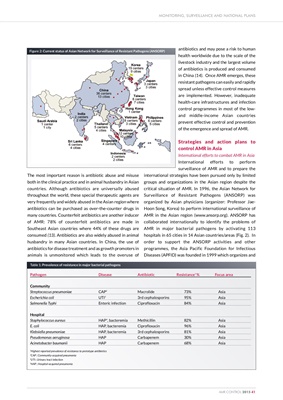
The most important reason is antibiotic abuse and misuse
both in the clinical practice and in animal husbandry in Asian
countries. Although antibiotics are universally abused
throughout the world, these special therapeutic agents are
very frequently and widely abused in the Asian region where
antibiotics can be purchased as over-the-counter drugs in
many countries. Counterfeit antibiotics are another inducer
of AMR: 78% of counterfeit antibiotics are made in
Southeast Asian countries where 44% of these drugs are
consumed (13). Antibiotics are also widely abused in animal
husbandry in many Asian countries. In China, the use of
antibiotics for disease treatment and as growth promoters in
animals is unmonitored which leads to the overuse of
antibiotics and may pose a risk to human
health worldwide due to the scale of the
livestock industry and the largest volume
of antibiotics is produced and consumed
in China (14). Once AMR emerges, these
resistant pathogens can easily and rapidly
spread unless effective control measures
are implemented. However, inadequate
health-care infrastructures and infection
control programmes in most of the lowand
middle-income Asian countries
prevent effective control and prevention
of the emergence and spread of AMR.
Strategies and action plans to
control AMR in Asia
International efforts to combat AMR in Asia
International efforts to perform
surveillance of AMR and to prepare the
international strategies have been pursued only by limited
groups and organizations in the Asian region despite the
critical situation of AMR. In 1996, the Asian Network for
Surveillance of Resistant Pathogens (ANSORP) was
organized by Asian physicians (organizer: Professor JaeHoon
Song, Korea) to perform international surveillance of
AMR in the Asian region (www.ansorp.org). ANSORP has
collaborated internationally to identify the problems of
AMR in major bacterial pathogens by activating 113
hospitals in 65 cities in 14 Asian countries/areas (Fig. 2). In
order to support the ANSORP activities and other
programmes, the Asia Pacific Foundation for Infectious
Diseases (APFID) was founded in 1999 which organizes and
MONITORING, SURVEILLANCE AND NATIONAL PLANS
AMR CONTROL 2015 41
Figure 2: Current status of Asian Network for Surveillance of Resistant Pathogens (ANSORP)
Table 1: Prevalence of resistance in major bacterial pathogens
Pathogen Disease Antibiotic Resistance
1 % Focus area
Community
Streptococcus pneumoniae CAP2
Macrolide 73% Asia
Escherichia coli UTI3
3rd cephalosporins 95% Asia
Salmonella Typhi Enteric infection Ciprofloxacin 84% Asia
Hospital
Staphylococcus aureus HAP4
, bacteremia Methicillin 82% Asia
E. coli HAP, bacteremia Ciprofloxacin 96% Asia
Klebsiella pneumoniae HAP, bacteremia 3rd cephalosporins 81% Asia
Pseudomonas aeruginosa HAP Carbapenem 30% Asia
Acinetobacter baumanii HAP Carbapenem 68% Asia
1Highest reported prevalence of resistance to prototype antibiotics
2CAP ; Community-acquired pneumonia
3UTI ; Urinary tract infection
4HAP ; Hospital-acquired pneumonia